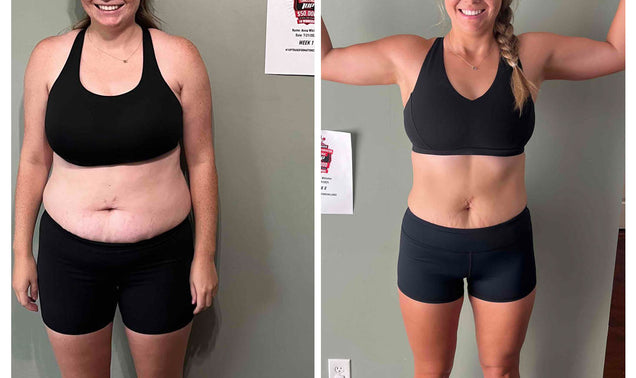Getting a good night's sleep is essential for losing weight, building muscle, and supporting overall health & well-being. But many of us struggle with falling and staying asleep. Fortunately, something as simple as manipulating your breathing technique can help calm your overactive mind, promote relaxation throughout your body, and enhance your overall quality of sleep.
In fact, a 2018 meta-analysis investigating how breath control can impact daily life concluded that breathing exercises help can beneficially influence “CNS activities (increased EEG alpha power and decreased EEG theta power) related to emotional control and psychological well-being in healthy subjects.”[1]
Put another way, working on your breathing can go a long way to reducing stress and helping you sleep better.
So, how do you breathe for better sleep?
Give these three breathing techniques a try to improve your sleep quality!
#1 Box Breathing
Box breathing is among the most well-known forms of breath work. It’s also known as “equal breathing” or sama vritti in yoga. Basically, you make the duration of each phase of a breath the same.
What are the four phases of breathing?
- Inhalation
- Retention (holding your breath)
- Exhalation
- Retention (keeping the tank “empty” until you start your next inhalation)
Most of us, naturally, inhale shortly after the exhale, but box breathing would have you wait as long as it took you to inhale (exhale) before continuing the cycle.
If you’re not used to regulating your breathing in such a fashion, try the 4-4-4-4 box breathing technique:
- Close your eyes
- Inhale through your nose while counting to four slowly.
- Hold your breath while counting slowly to four. (Keep your jaw relaxed, but mouth closed)
- Slowly exhale for 4 seconds.
- Repeat this process at least three times and up to a total of four minutes (or until you feel relaxed)
#2 Belly Breathing
Also known as diaphragmatic breathing, belly breathing involves engaging the diaphragm to take deep, slow breaths. Your focus should be to make each breath slow, steady, and deep, which helps your mind and body to relax while also delivering extra oxygen to your whole body. This ultimately helps promote relaxation and supports recovery. Research demonstrates that belly breathing is effective for reducing stress & anxiety as well as improving sleep quality.[2,3]
To practice belly breathing:
- Lie down on your back (or sit comfortably) with one hand on your stomach.
- Inhale deeply through your nose, allowing your abdomen to rise as you fill your lungs with air.
- Exhale slowly through your mouth, feeling your stomach recede towards your spine.
- Repeat until you feel at peace and ready for sleep.
#3 Alternate Nostril Breathing
Another breathing technique practice in yoga (known as Nadi shodhana pranayama), alternate nostril breathing has been shown in scientific research to reduce stress, which may help to improve sleep quality.[4,5]
To perform this breathing technique at night:
- Lie down in bed (or sit cross-legged in your bed or next to it).
- Completely exhale.
- Place your right thumb against your right nostril and keep your thumb in place.
- Inhale through your left nostril.
- Now close your left nostril with your left thumb.
- Exhale through your right nostril.
- Inhale through your right nostril.
- Open your left nostril, close your right nostril and then exhale through the left side.
- This is one cycle.
- Repeat this cycle for 3-5 minutes.
Additional Tips for Improving Sleep Quality
If you’re experiencing poor sleep due to anxiety or stress, the breathing techniques outlined above may help you get the rest you’ve been sorely needing. Other tips for improving sleep quality worth considering are:
- Eliminating caffeine/alcohol before bed
- Making your bedroom cool and dark
- Eliminate blue light exposure at least two hours before bedtime
- Use a sleeping mask and/or earplugs
- Listen to calming music
- Bedtime yoga/stretching/prayer
- Journaling
It may also be helpful to use a nighttime relaxation supplement, such as 1UP Relax, or a PM recovery and sleep supplement, such as 1UP Recharge PM or Beauty Dream PM.
Takeaway
Sleep is essential for making the most of your workouts, supporting recovery, and promoting overall health and mental well-being. Yet, many of us still struggle to achieve quality sleep consistently.
Breathing exercises are a no-cost solution that can help you lessen the worries and stressors of the day, enabling you to relax and achieve the deep, restorative sleep needed to recharge, recover, and get results!
References
- Zaccaro A, Piarulli A, Laurino M, Garbella E, Menicucci D, Neri B, Gemignani A. How Breath-Control Can Change Your Life: A Systematic Review on Psycho-Physiological Correlates of Slow Breathing. Front Hum Neurosci. 2018 Sep 7;12:353. doi: 10.3389/fnhum.2018.00353. PMID: 30245619; PMCID: PMC6137615.
- Ma X, Yue ZQ, Gong ZQ, Zhang H, Duan NY, Shi YT, Wei GX, Li YF. The Effect of Diaphragmatic Breathing on Attention, Negative Affect and Stress in Healthy Adults. Front Psychol. 2017 Jun 6;8:874. doi: 10.3389/fpsyg.2017.00874. PMID: 28626434; PMCID: PMC5455070.
- Liu Y, Jiang TT, Shi TY, Liu YN, Liu XM, Xu GJ, Li FL, Wang YL, Wu XY. The effectiveness of diaphragmatic breathing relaxation training for improving sleep quality among nursing staff during the COVID-19 outbreak: a before and after study. Sleep Med. 2021 Feb;78:8-14. doi: 10.1016/j.sleep.2020.12.003. Epub 2020 Dec 9. PMID: 33383396; PMCID: PMC7724962.
- Naik GS, Gaur GS, Pal GK. Effect of Modified Slow Breathing Exercise on Perceived Stress and Basal Cardiovascular Parameters. Int J Yoga. 2018 Jan-Apr;11(1):53-58. doi: 10.4103/ijoy.IJOY_41_16. PMID: 29343931; PMCID: PMC5769199.
- Sinha AN, Deepak D, Gusain VS. Assessment of the effects of pranayama/alternate nostril breathing on the parasympathetic nervous system in young adults. J Clin Diagn Res. 2013 May;7(5):821-3. doi: 10.7860/JCDR/2013/4750.2948. Epub 2013 May 1. PMID: 23814719; PMCID: PMC3681046.






